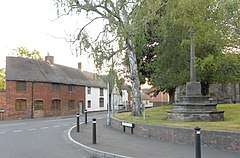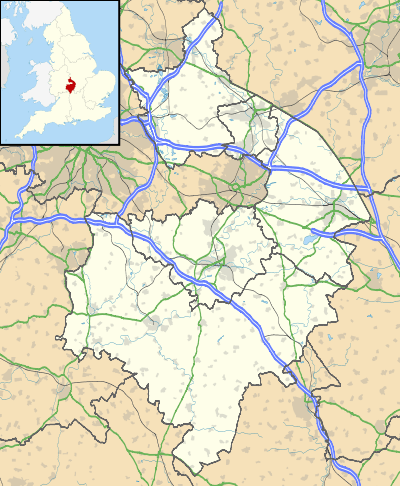Clifton-upon-Dunsmore
Clifton-upon-Dunsmore is a village and civil parish in the Rugby borough of Warwickshire in England on the north-eastern outskirts of Rugby, approximately 2 miles (3.2 km) from Rugby town centre. The population of the parish taken at the 2011 census was 1,304.[1] Clifton is counted as being part of the Rugby built-up area,[2] but is considered separate from the town.
| Clifton-upon-Dunsmore | |
|---|---|
 Looking towards Church Street from Lilbourne Road. | |
 Clifton-upon-Dunsmore Location within Warwickshire | |
| Population | 1,304 (2011) |
| OS grid reference | SP529764 |
| Civil parish |
|
| District |
|
| Shire county | |
| Region | |
| Country | England |
| Sovereign state | United Kingdom |
| Post town | RUGBY |
| Postcode district | CV23 |
| Dialling code | 01788 |
| Police | Warwickshire |
| Fire | Warwickshire |
| Ambulance | West Midlands |
| UK Parliament | |
Location
Clifton bears the distinction of being the most easterly village in Warwickshire (and of the entire West Midlands region). The village is located on a fairly steep hill, which at its highest point elevates to 400 feet (120 m) above sea level. The Oxford Canal runs past at the foot of the hill to the south-west. To the north of the village is the River Avon.[3][4]
Around 1.2 miles (1.9 km) north-east of Clifton is Dow Bridge, where the A5 road (Watling Street) crosses the River Avon, and the counties of Warwickshire, Northamptonshire and Leicestershire meet, forming a tripoint.[4]
History
The area around Clifton was settled during Roman times; around one and a half miles north of Clifton is the former Roman town of Tripontium.[4] The area around Clifton has been suggested as a possible location of the Defeat of Boudica.[5] The name of the village likely derives from 'Cliffe' in Old English signifying rocky ground, and 'Dunsmore' on top of a hill.[4]

During the time of Edward the Confessor Clifton was in the hands of Alwyn, the Sheriff of Warwick who gave his land at Clifton to Coventry Priory; monks from which were likely responsible for building a church here dedicated to St. Mary, which at the time of the Domesday Book was the mother church to the then smaller settlement of Rugby. That church no longer exists, though the present one (of the same name) dates back to the 13th century, with later additions, including the current tower which was added in the 16th century replacing a spire which had collapsed in a storm.[3][4] The church is now grade II* listed.[6]
The ancient parish of Clifton included the nearby settlements of Brownsover and Newton; the former is now part of Rugby, and the latter is now a separate civil parish. To the south-east of the village and within the parish was the former Rugby Radio Station,[7] which operated between 1926 and 2007, and is now being turned into a large housing development called Houlton.
The village was once served by Clifton Mill railway station on the former Rugby and Stamford Railway. The station opened in 1864, and was closed in 1953, and the line in 1966.[8]
At the village was once Rugby Racecourse, which was used for horse racing from 1862 until 1936. The National Hunt steeplechase, now part of the Cheltenham Festival, was held here in 1862.[9][10]
Commerce

In the centre of the village are small shops, St Mary's Church (whose registers for which date back to 1594), and the Bull Inn public house, which was originally a farmhouse, and according to a plaque on the entrance it was built in 1598 and became a public house in 1825. There were rooms for travellers and stables for their horses, some evidence of which still survives. There was formerly a second public house, the Red Lion, which was converted to cottages and the Townsend Memorial Hall in the late 19th century.
Part of the North Oxford Canal also travels within the boundaries of the village, the canal opened in 1790 but during the 1800s they cut 14 miles off its length straightening it to what is now the most navigated part of the canal system in the UK. Part of the old route fell subsequently fell into decay, until it was reopened in 2016/2017 by Clifton Wharf where there is a hire fleet based. Clifton Cruisers has been operating from the site at Clifton Wharf since the early 1970s and now has a cafe & bar, The Canal Lounge at Bridge 66.
Education
The village has a primary school, Clifton-upon-Dunsmore Primary School which has been in continuous use since 1850.[3] Secondary-age pupils attend schools in Rugby.
References
- "CLIFTON UPON DUNSMORE Parish in West Midlands". City Population. Retrieved 1 January 2019.
- "RUGBY in Warwickshire (West Midlands) Built-up Area Subdivision". City Population. Retrieved 5 August 2020.
- Geoff, Allen (2000). Warwickshire Towns & Villages. Sigma Press. p. 42. ISBN 1-85058-642-X.
- The Warwickshire Village Book. Countryside Books. 2000. pp. 46–48. ISBN 1-85306-652-4.
- "Boudica and Clifton... the final battle of the Celtic Revolt of AD60". Clifton-upon-Dunsmore Local History Group. Archived from the original on 4 February 2007. Retrieved 2 October 2019.
- Historic England. "CHURCH OF ST MARY THE VIRGIN (1233440)". National Heritage List for England. Retrieved 2 October 2019.
- "Parishes: Clifton-on-Dunsmore". British History Online. Retrieved 2 October 2019.
- "Clifton Mill station". Retrieved 23 April 2016.
- "RUGBY'S LOST RACECOURSE". Our Warwickshire. Retrieved 2 October 2019.
- Stevens, Peter, History of the National Hunt Chase 1860-2010, pp. 15–16. ISBN 978-0-9567250-0-4
External links
| Wikimedia Commons has media related to Clifton upon Dunsmore. |
- Clifton upon Dunsmore Parish Website a portal of information and events in the village
- Clifton upon Dunsmore Local History Group A more detailed history of the village
- Our Warwickshire page about Clifton-upon-Dunsmore includes articles and old photographs